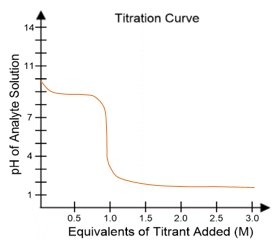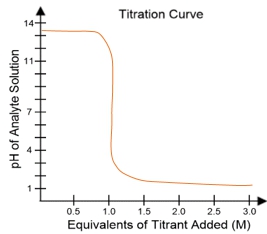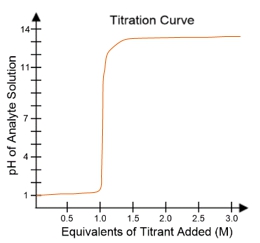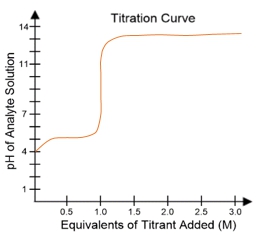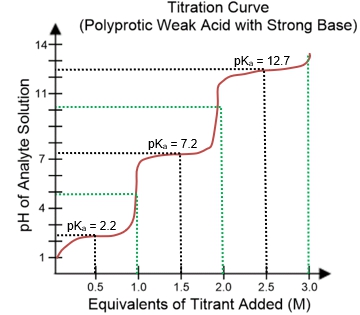In this video, we're going to review titrations. So I'm sure most of you guys have performed titrations in your previous chemistry labs. Recall that a titration is just a lab technique that measures the pH changes of acid-based solutions. Titrations are typically used to determine the \( pK_a \) values of weak acids, as well as the concentrations of weak acids. Titrations can also be used to determine the concentrations of strong acids, but recall from our previous lesson videos that in biological systems, most of the acids are weak acids. Moving forward in our course, we're going to focus most of our attention on the titrations of weak acids. Recall that the way titrations work is that there's an acid-based solution of known concentration called the titrant, and the titrant is gradually added to another solution of unknown concentration called the analyte solution, because this is the solution being analyzed. The titrant is continuously added to the analyte solution until a point of neutralization is reached. This point of neutralization is the exact point where the moles of titrant that are being added are exactly equal to the moles of analyte that are present. The point of neutralization, when it is reached, is indicated by a color change, making it easy to detect visually.
Again, a titration is typically used to determine two different things: the concentration of an acid or a base in a solution, and the \( pK_a \) of a weak acid. Titrations cannot be used to determine the \( pK_a \) of strong acids, but this limitation is acceptable to biochemists because, again, most of the acids in biological systems are weak acids. A titration curve is just a plot of the titration data, which has the analyte pH on the y-axis, and the amount of titrant being added on the x-axis. Remember that the titrant is continuously added to the solution until a point of neutralization is reached. This point of neutralization is called the equivalence point, or also known as the endpoint, because once neutralization has been reached, that is the end of an acid, so that's why it's called an endpoint.
In our example below, we're going to look at the titration of a strong acid with a strong base. The reason we are looking at the titration of a strong acid in this example is that when we're trying to refresh our memories of titrations, it's easiest to examine the titration of a strong acid with a strong base. The setup for a typical titration features an Erlenmeyer flask shown below, which contains a pink solution, the analyte solution. This analyte solution, in this example, is a strong acid. Notice that in this analyte solution we have a pH electrode, which is going to continuously measure the pH of the analyte solution as we start to add titrant. Above, we have a burette instrument, a volumetric instrument that contains the solution of known concentration called the titrant; in this case, this is a strong base. We continue to add the titrant, slowly into the solution below, the analyte solution, until the point of neutralization is reached, which is indicated by a color change. We can then calculate the \( pK_a \) as the stopcock allows us to control the amount of titrant being added. The titration curve for the strong acid with a strong base has pH on the y-axis and the amount of titrant being added on the x-axis, which can sometimes show the volume of the titrant, but here it shows the equivalents of titrant in molarity. A 0.2 molar equivalent of titrant added means that 20% of the analyte solution has been neutralized, a 0.6 molar equivalent means that 60% has been neutralized, and a 1 molar equivalent means that 100% of the analyte solution has been neutralized; this is the equivalence point. At exactly 1 molar equivalent, we have a green dotted line indicating the equivalence point, which for a titration of a strong acid with a strong base always shows up at a pH of 7. We can tell by the titration curve that we are using a strong acid as the analyte and a_b strong base as the titrant because before adding any titrant, the pH of the analyte solution is extremely low, below pH 1. After reaching the equivalence point, the pH rises significantly, indicating the use of a strong base. The equivalence point arrives exactly at a pH of 7. In our next practice problem, we'll analyze the titration curves to predict the type of titration being performed. See you in that practice video.
